Contents
Market Overview
Macro Review
A new cocktail of risks enter the fray. We continue to see DXY trade on the U.S. growth differential relative to the RoW and on its superior vaccination rollout. President Biden’s aim of topping 200m doses by the end of April buoyed U.S. equities and credibly supported that theme. BAML took this one-step further and raised their U.S. growth forecast to 7% in 2021 and 5% in 2022. Stronger growth with higher inflation via the PCE release on Friday and Michigan inflation expectations is another sign, yet the reflationary momentum has eased. U.S. Treasuries tightened 5-7bp this week, with the added fracture of a weak 7yr auction (2.6bp tail). Meanwhile, Fedspeak revealed more insight into the four 2022 dots calling for a hike. Bostic highlighted that his vote was unchanged since December, meaning the hawks calling for a hike in 2022 are Rosengren, Mester, George and Kaplan. However, Kaplan won’t have a vote until 2023, nor will Bostic have a vote until 2024, so there’s motive for a dovish outcome in rates. Needless to say, a stronger growth picture in the U.S. and UK partially exiting its extensive lockdown bodes well, yet continental Europe is moving in the opposite direction (and financial conditions are tightening). Europe isn’t alone as parts of ASIA (Philippines) and LATAM (Chile) are re-entering lockdown. Elsewhere, the impact associated with the Suez blockage has been mixed; we haven’t seen freight rates spike, nor has the impact on oil been overly revealing.
EM Credit Update
EM Credit ended the week up 0.1% with spreads 8-10bp wider as U.S. Treasuries tightened 5-7bp. At the sovereign-level, Sri Lanka, Slovakia and Georgia outperformed, while Turkey, Zambia and Argentina lagged. As we flagged in our previously weekly, the EM duration trade has begun to unfold. Sentiment for EM Sovereign Credit that is longer than 10 years in maturity continues to build, which was further complimented by the UST 30yr rallying 5-6bp this week. This stands out at the index-level, despite Turkey’s long-end selling off by 40-70bp in spread (down 5-7pts).
The Week Ahead
The trend in EM may well focus on how larger EM Central Banks like Turkey, Brazil and Russia have hiked rates, but that trend did not extend to South Africa, nor Mexico. Rate decisions should be a quieter affair in the week ahead with Kenya (7.0%) and Chile (0.5%), although the peso was clearly vulnerable following the S&P downgrade to Single A. Beyond that EM PMIs will fill up the calendar out of China, Poland and Czech Republic. Elsewhere, Polish inflation is expected to pick-up to 2.8% and will follow releases out of Indonesia, Peru and South Korea. We would expect Turkey’s trade deficit release to be closely watched and subsequently widen beyond $3bn, taking the 12-month rolling trade deficit to >$48bn.
This week’s emerging markets highlights discussed below include: Abrupt firing of the Central Bank of Turkey’s (CBRT) Governor by President Erdogan roils markets and raises the stakes in the event of a policy mistake by the new CBRT management team; Argentina continued high level dialogue with the IMF; Province of Buenos Aires (PBA) revised restructuring offer still leaves wide gap; Mexico and South Africa Central Banks rates on hold; and Global emerging markets corporates in focus: Turkish banks in the hot seat (again).
Fixed Income
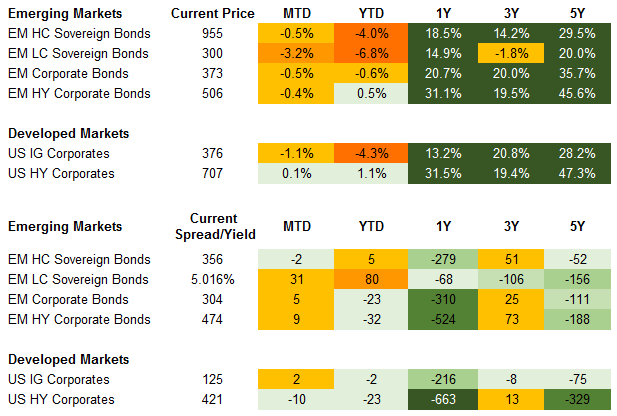
Equities
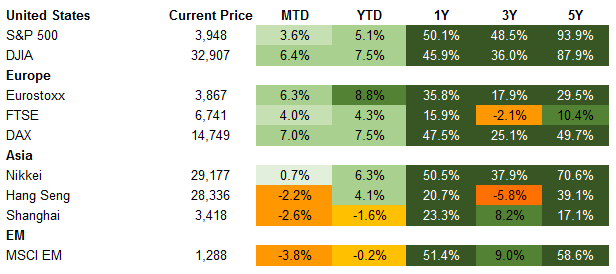
Commodities

Source for data tables: Bloomberg, JPMorgan, Gramercy. EM Fixed Income is represented by the following JPMorgan Indicies: EMBI Global, GBI-EM Global Diversified, CEMBI Broad Diversified and CEMBI Broad High Yield. DM Fixed Income is represented by the JPMorgan JULI Total Return Index and Domestic High Yield Index. Fixed Income, Equity and Commodity data is as of March 26, 2021 (Mid Afternoon).
Emerging Markets Weekly Highlights
Abrupt firing of the Central Bank of Turkey’s (CBRT) Governor by President Erdogan roils markets and raises the stakes in the event of a policy mistake by the new CBRT management team
Event: In a dramatic turn of events, Turkish President Erdogan fired CBRT Governor Naci Agbal by a decree published after midnight last Saturday and replaced him with Sahap Kavcioglu, a former Halkbank official and pro-government columnist, who has expressed support for a number of controversial economic policy decisions by Berat Albayrak, the President’s son-in-law and former finance minister.
Gramercy Commentary: Naci Agbal was appointed Governor of the CBRT in early November 2020 and in his short 4.5 months in charge, managed to engineer an impressive market-friendly turnaround in the Central Bank’s policy framework that underpinned strong market outperformance by Turkish assets, led by the currency (TRY). Under Agbal’s leadership, the CBRT tightened monetary policy by 875 bps to 19% from 10.25% in order to break Turkey’s notorious vicious cycle of weak TRY/unanchored inflation expectations and rebuild a comfortable positive interest rate cushion. Importantly, Agbal’s policy pivot managed to restore CBRT’s market credibility, attracting significant inflows into the economy over the last few months. His abrupt firing by President Erdogan just two days after the CBRT’s decisive consensus-beating 200 bps rate hike on March 18th plunged Turkish markets into turmoil, reversing much of the gains accumulated since November. Going forward, the trajectory of Turkish markets as well as the overall macroeconomic environment hinges on CBRT’s policy direction under the new leadership and its ability and willingness to maintain and even further tighten the monetary policy stance, if necessary. The Turkish economy is facing a weak external liquidity position characterized by historically low FX reserve levels and a Current Account that has reverted to its traditional large structural deficit. Turkey’s ability to narrow and finance its external deficit is subject to a continuing recovery from the pandemic shock, but also to monetary policy being sufficiently tight. Furthermore, the turbulence at the CBRT comes at a time when global macro conditions have also taken a negative turn from the perspective of Turkey’s external vulnerabilities, due to higher UST rates and commodity (oil) prices as well as global reflation concerns. In such an environment, we think it might be necessary for the CBRT to be willing to err on the side of even higher interest rates/tighter policy going forward. This is especially true given credibility concerns that resurfaced in the wake of Agbal’s unexpected dismissal and a less benign external backdrop. In addition, new governor Kavcioglu has expressed in the past certain unorthodox views on monetary policy that markets will likely find problematic. As such, he is unlikely to be given the benefit of the doubt in case of a policy mistake early in his tenure, for example at the next scheduled monetary policy meeting on April 15th, and if FX/inflation pressures in the economy escalate quickly. Against this backdrop and materially higher policy uncertainty, we have turned cautious and think the TRY is likely to remain subject to increased volatility and pressure in the near-term.
Argentina continued high level dialogue with the IMF; Province of Buenos Aires (PBA) revised restructuring offer still leaves wide gap
Event: Economy Minister Martin Guzmán and his team held meetings with IMF Managing Director, Kristalina Georgieva, the Western Hemisphere Deputy Director, Julie Kozack, Mission Chief, Luis Cubeddu, as well as the broader IMF Argentina team. The meetings resulted in “progress in defining some key principles that could underpin an economic program to help address Argentina’s near- and medium-term challenges”. Both sides acknowledged that inflation is a ‘multifaceted phenomenon’ which requires a mixed policy approach. There was an agreement that policies which support growth in higher value-add exports and productivity as well as deepening of the local market are important for FX reserve recovery and broader economic resilience. Meanwhile, the PBA improved its restructuring terms, eliminating principle haircuts, fully recognizing PDI through March 2021, reducing maturity of new bonds by a year, and slightly increasing average coupons. This results in an estimated recovery value of around 38 cents using an exit yield assumption 100 bps wide of the current sovereign curve.
Gramercy Commentary: Market consensus remains for an eventual deal with the IMF albeit now more likely to occur in 4Q21-1Q22 with potential for an earlier resolution if conditions allow for it. The improving external demand backdrop, decent harvest dollar inflows, and capital controls combined with prospects for an additional $4.4bn in SDR liquidity have provided the government with the optionality, albeit high risk, to extend negotiations and focus on domestic politics ahead of the mid-terms in October. The extent of the positive impact of an ultimate agreement with the Fund continues to depend on the ability of the government to deliver on program criteria and sustainably accumulate FX reserves. With respect to the PBA restructuring, despite the improved offer and increased legal pressure, the gap with bondholders remains sizeable and will likely result in prolonged negotiations certainly beyond the currently set deadline of March 26th.
Mexico and South Africa Central Banks rates on hold
Event: On Thursday, Banxico and SARB kept policy rates unchanged at 4.0% and 3.5%, respectively. This followed a slightly higher than anticipated 1H March inflation print in Mexico of 4.1% YoY (vs. 3.9% survey) and softer than envisaged February inflation print in South Africa of 2.9% YoY (vs. 3.1% survey).
Gramercy Commentary: The outcomes were generally anticipated by the market albeit with some surprise on the unanimous nature of the decisions particularly in the case of Mexico where there were a few calls for another cut. While hiking cycles are likely on the horizon in both countries, we believe there may be greater near term pressure in the case of Mexico where real yield erosion may happen faster amid sticky inflation, comparatively stronger near term growth on U.S. recovery and better COVID-19 dynamics thanks to seasonal effects as well as vaccinations.
Global emerging markets corporates in focus: Turkish banks in the hot seat (again)
Event: Unexpected changes at the Central Bank of Turkey led to increased risk premiums, including on Turkish banks’ bonds. Concerns about liquidity, capital, asset quality and other metrics have re-emerged.
Gramercy Commentary: The Turkish banks are clearly accustomed to challenges. In the past decade, there have been several elections, a taper tantrum, too many rating changes to count (both upgrades and downgrades), changes in ownership and even an attempted coup. The latest Central Bank Governor is the fourth to be appointed in less than two years. Major Turkish banks may well be challenge-weary, but are also challenge-ready. Considering margins, it is likely that the latest 200 bps rate hike will add to pressures in the short term. However, at least a portion of banks’ loan books would then reprice. Lenders had expected rate rises to reverse much later in the year, as inflation moderated. While inflation remains high, income from CPI-linkers can serve as an offset when core margins come under pressure. On asset quality, regulatory forbearance covering the recognition of impaired assets is still expected to come to an end in June. A number of banks have continued to set aside provisions against exposures as though forbearance did not apply. Added to this, banks have often disclosed impaired loan ratios with and without regulatory forbearance, providing transparency to the market. On foreign currency (FC) liquidity, while Eurobond issuance has not been as prolific as in some years, FC liquidity coverage ratios at Turkey’s major banks have remained well above 100%. Banks have succeeded in rolling over syndicated loans, even in much more challenging times (though developments in the loan market will likely be closely watched again this year). It’s worth noting also that the demand for foreign currency-denominated loans from the banks’ clients has been subdued and was expected to remain so this year. Solid foreign currency liquidity metrics mean major banks have not ruled out bond buybacks, with some even having programs in place. On capital, regulatory forbearance again applies. Banks can use the average exchange rate of the last 252 days in calculations, until June 2021. Such forbearance is not unique to Turkey. As with asset quality, major lenders tend to disclose what capital ratios would be with and without temporary amendments to prevailing regulation. Finally, regarding the Basel III Tier 2 securities, gone concern (rather than going concern) loss absorption applies i.e. the bonds may be permanently written down if the banking regulator determines that the issuer has become, or is likely to become, non-viable following a consolidated or unconsolidated loss. ‘Non-viable’ is defined as the point at which the banking regulator determines that the lender’s banking license is to be revoked or shareholders’ rights, management and supervision are to be transferred to Turkey’s Saving and Deposit Insurance Fund. The next few months will undoubtedly be interesting, starting with the scheduled Central Bank rate-setting meeting on April 15th. There may be more volatility to come. Turkey’s major banks may be less surprised, and better prepared, for what the future brings than the market sometimes gives these lenders credit for.
Emerging Markets Technicals
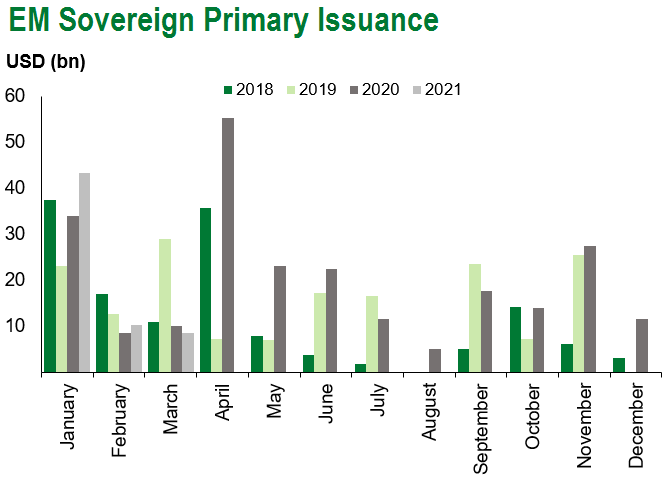
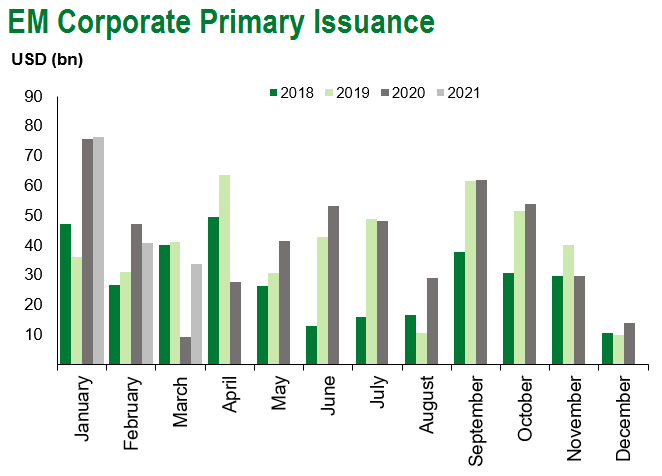
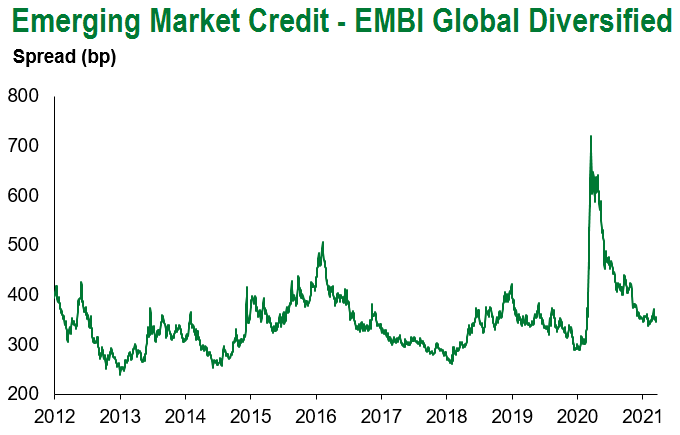
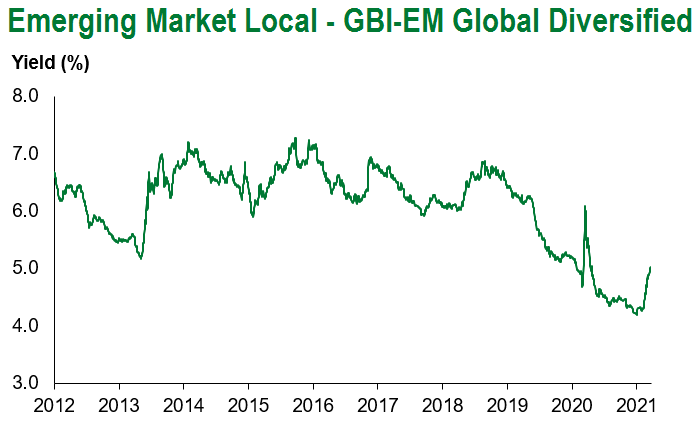
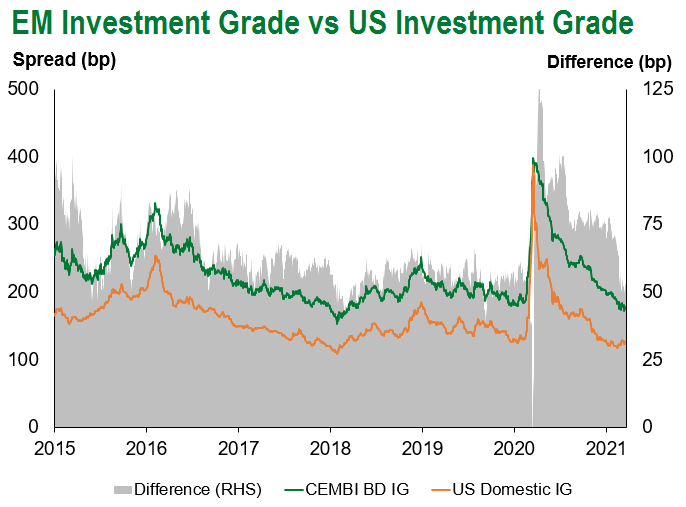
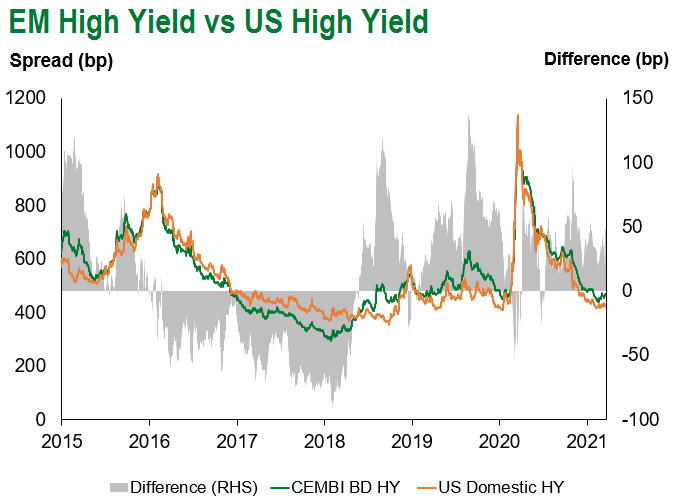
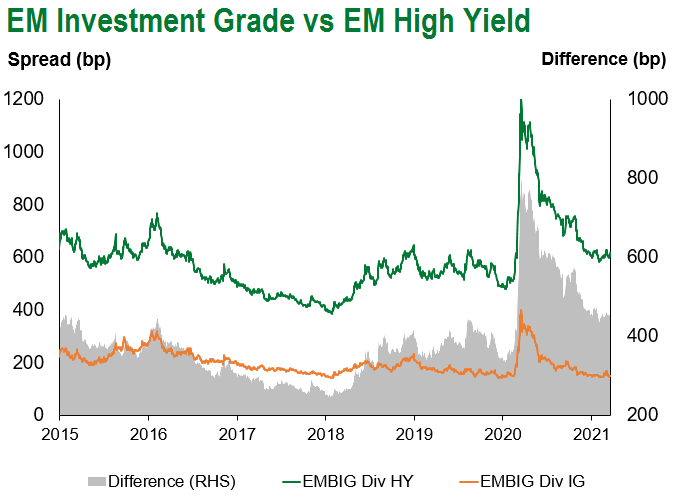
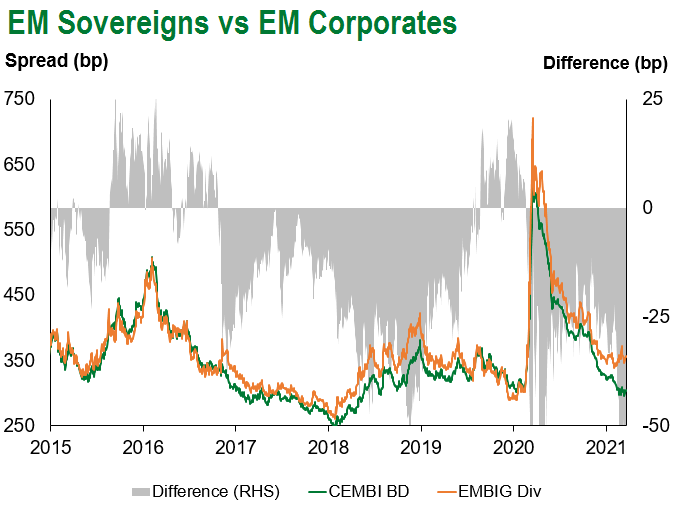
Emerging Markets Flows
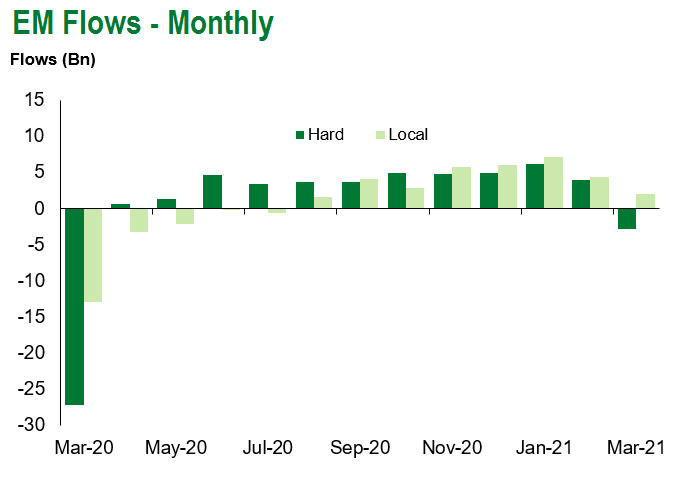
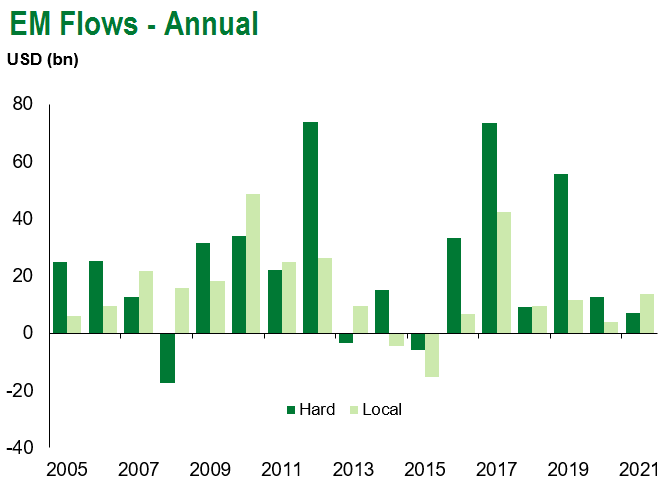
Source for graphs: Bloomberg, JPMorgan, Gramercy. As of March 26, 2021.
COVID Resources
Emerging Markets COVID-19 Case Summary
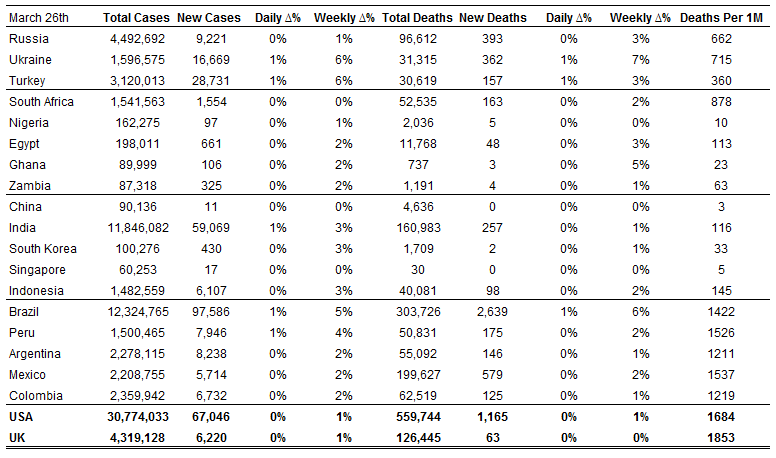
Source: Worldometer as of March 26, 2021.
Additional Crisis Resources:
Johns Hopkins COVID-19 Case Tracker
For questions, please contact:
Kathryn Exum, Senior Vice President, Sovereign Research Analyst, [email protected]
Petar Atanasov, Senior Vice President, Sovereign Research Analyst, [email protected]
Tolu Alamutu, CFA, Senior Vice President, Corporate Research Analyst, [email protected]
James Barry, Vice President, Corporate Research Analyst, [email protected]
This document is for informational purposes only. The information presented is not intended to be relied upon as a forecast, research or investment advice, and is not a recommendation, offer or solicitation to buy or sell any securities or to adopt any investment strategy. Gramercy may have current investment positions in the securities or sovereigns mentioned above. The information and opinions contained in this paper are as of the date of initial publication, derived from proprietary and nonproprietary sources deemed by Gramercy to be reliable, are not necessarily all-inclusive and are not guaranteed as to accuracy. This paper may contain “forward-looking” information that is not purely historical in nature. Such information may include, among other things, projections and forecasts. There is no guarantee that any forecasts made will come to pass. Reliance upon information in this paper is at the sole discretion of the reader. You should not rely on this presentation as the basis upon which to make an investment decision. Investment involves risk. There can be no assurance that investment objectives will be achieved. Investors must be prepared to bear the risk of a total loss of their investment. These risks are often heightened for investments in emerging/developing markets or smaller capital markets. International investing involves risks, including risks related to foreign currency, limited liquidity, less government regulation, and the possibility of substantial volatility due to adverse political, economic or other developments. The information provided herein is neither tax nor legal advice. Investors should speak to their tax professional for specific information regarding their tax situation.